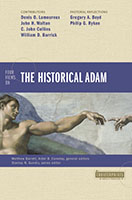It seems that each generation of Christians must face its own set of defining questions, and the question of the historicity of Adam is certainly one of those questions for our day. It is an enormously important question with far-reaching implications, and so it was inevitable that this book would appear, Four Views on the Historical Adam. Here editors Mathew Barrett (Assistant Professor of Christian Studies at California Baptist University and executive editor of Credo Magazine – www.credomag.com) and Ardel B. Caneday (Professor of New Testament and Greek at the University of Northwestern – St. Paul) bring together representatives of four leading approaches to the question. Each professes to be Christian, and each professes faith in God the Creator. But it seems that the commonality ends about there.
We are happy that Drs. Barrett and Caneday could speak to us about their work and, more importantly, about the issue it addresses.
 Books At a Glance (Fred Zaspel):
Books At a Glance (Fred Zaspel):
Can you give us a brief snapshot of the current theological landscape that illustrates why a book like this necessary?
Barrett & Caneday:
Thank you for this opportunity to comment on Four View on the Historical Adam. We’re delighted to be invited to feature this book, which we believe will provide readers instructive access to four competing views and does so for a time such as this when the historic faith of Christians is in need of renewed defense.
As we show within the introduction to Four Views on the Historical Adam, belief in Adam’s historicity, that Adam was the first human formed by the direct and immediate act of the Creator has been the historic Christian belief. To be sure, this belief has been significantly challenged since the rise of modern science, especially scientism. However, even though Christians, especially since the nineteenth century, have not agreed on the nature of the six days of creation as presented in Genesis, they have agreed that Adam was a historical man, the first human from whom all humans have descended. This is true of B. B. Warfield of Princeton Seminary, of James Orr (The Fundamentals), of C. I. Scofield (Reference Bible), of William Jennings Bryan (Scopes Trial), or of Henry Morris and John C. Whitcomb, Jr. (The Genesis Flood). Of these, only Morris and Whitcomb believed that the six days of creation consisted of six actual twenty-four hour days. Nevertheless, all resolutely believed in the historical Adam.
Of course, ever since Charles Darwin’s On the Origin of the Species (1859) many have become attracted to the theory of evolution, even embracing it and mingling it, if this is possible, with the Christian faith and calling it theistic evolution. Some, such as Denis Lamoureux, one of our contributors, prefer to identify their view as evolutionary creation. All who embraced this notion found considerable encouragement in 2006 with the publication of Francis Collins’ The Language of God: A Scientist Presents Evidence for Belief, which would be better sub-titled A Scientist Endeavors to Make Evolution Acceptable to Evangelical Christians. The next year Collins, who was Director of the Human Genome Project, founded BioLogos, an organization that is devoted to call upon “the church and the world to see the harmony between science and biblical faith as we present an evolutionary understanding of God’s creation.” Collins coined the term, “BioLogos,” as a more palatable designation for “theistic evolution.”
It is reasonable to say that BioLogos has emboldened many to emerge from the shadows to declare openly and plainly their acceptance of evolution and to do so with withering and derisive rhetoric toward Evangelicals who persevere in their belief in the historical Adam. Perhaps no one is more emblematic in this regard than Peter Enns who published in 2012 The Evolution of Adam: What the Bible Does and Doesn’t Say about Human Origins. He equates Evangelicals who believe in the historical Adam with poor, benighted souls who believe that the earth is flat, a dismissive, mean, and false characterization of fellow Christians, in our estimation.
As to the current landscape that illustrates why Four Views on the Historical Adam is necessary, there is no better illustration than what is taking place at Bryan College, named after William Jennings Bryan. The fourth affirmation in Bryan College’s Statement of Faith is belief “that the origin of man was by fiat of God in the act of creation as related in the Book of Genesis; that he was created in the image of God; that he sinned and thereby incurred physical and spiritual death.” Despite the clarity of this affirmation, various faculty members have either come to embrace evolution since they accepted appointments at the college or they surreptitiously joined the faculty. President Stephen D. Livesay and the Board of Trustees have found it necessary to draft a statement to clarify for the faculty that the fourth affirmation means, “We believe that all humanity is descended from Adam and Eve. They are historical persons created by God in a special formative act, and not from previously existing life forms.” This clarification has caused no small stir among faculty and alumni and various news media. However, if Bryan College is going to maintain its very reason for existence on Bryan Hill, overlooking the city of Dayton, Tennessee, and the Rhea County courthouse where the State of Tennessee v. John Scopes trial took place in 1925, then surely the action the President and Board have taken is proper and necessary, even if difficult and painful. Scripturally sound Christian affirmation is at stake.
 Books At a Glance:
Books At a Glance:
Let’s talk history. It goes almost without saying, of course, that the dominant view of Christians historically has been that of a historical Adam, but how did the various changes and nuances come about? Was evolutionary thinking the only factor at play?
Barrett & Caneday:
Evolutionary creationists and theistic evolutionists, such as Peter Enns, acknowledge that Jesus Christ and the apostle Paul believed in the historical Adam and that he was the progenitor of the entire human race. With Jesus and with Paul, Christians have historically believed the same. Augustine, whose beliefs concerning creation are not fully clear, certainly believed in the historical Adam. This is made obvious in his theological commentary on Paul’s argument in Romans 5 concerning the entrance of sin and death by way of Adam’s disobedience, which has profoundly shaped Christian beliefs concerning human sinfulness and how humans became sinful.
Prior to Darwin’s influence, Thomas Chalmers (1780-1847), a Scottish churchman and theologian, popularized what has come to be called the “gap theory” or “gap creationism.” He attempted to integrate Christian faith with scientific and geological observations which he believed necessitated positing an old-earth creation but still could embrace the six-day creation of Genesis 1 as entailing a series of six actual twenty-four hour days. The posited gap stood between creation as described in Genesis 1:1 and 1:2.
As indicated earlier, since the rise of modern geological research and scientific inquiry, Christians have disagreed upon the age of the earth. This was true even prior to the ascendancy of Darwin’s theory of evolution, but Christians have also historically agreed that Adam was a historical person from whom all humanity has descended. So, yes, evolutionary thinking is the principal factor that incites a fundamentally different reading of Genesis 1 & 2, which regards the creation account to be mythical not historical or that the creation account displays “ancient science” not “true science” which “modern science” claims to be.
It is noteworthy and troubling that the folks at BioLogos announced on April 7, 2014, “Over the next few weeks on the blog, we’ll be interviewing three of the contributors to the book – Denis Lamoureux, John Walton, and C. John (Jack) Collins. None of them speaks for BioLogos, but all articulate positions that can be seriously considered alongside the scientific evidence.” It’s worthy of note that only three of the views published in a Zondervan Four Views book receive any mention or attention at BioLogos. We’re grateful that BioLogos is featuring Four Views on the Historical Adam with interviews of contributors, but we’re duly troubled that they exhibit the very Fundamentalist demeanor that they, along with us, properly dislike and reject as displayed by Fundamentalists of the last century. Whereas earlier Fundamentalists were often dogmatically dismissive of others with whom they disagreed, though the folks at BioLogos may object, they are displaying the same Fundamentalist demeanor by dogmatically dismissing anyone whose beliefs stand most directly contrary to their own. Again, even though they may object, for them, the authority of evolutionary scientism both displaces Scripture’s authority and warrants their public shunning of William Barrick, the fourth contributor to Four Views on the Historical Adam. It is not as though Dr. Barrick is some kind of modern-day Neanderthal, for the view he advocates is the same view that our Lord Jesus Christ, the apostle Paul, Martin Luther, John Calvin, and most Christians believed until the rise of Darwinism and its variations in the nineteenth and twentieth centuries have called into question the intellectual credibility of anyone who rejects evolutionary theory.
As C. S. Lewis so aptly cautions us, we must be wary of indulging chronological snobbery, of presuming that modernity corrects all the beliefs of previous generations, as though they were benighted.
Books At a Glance:
In your own judgment, what makes this such an important issue? What is at stake? How does it impact other areas of theology?
Barrett & Caneday:
Why did we collaborate with Zondervan to put together a highly reputed team of contributors with varied views, to publish Four Views on the Historical Adam? We did so because we saw that no one else was doing so, and we were deeply concerned at the growing number of published rejections of the historic Christian belief in the historical Adam.
We believe that major Christian beliefs are at stake in the dispute over Adam’s historicity. If, as those who reject the historical Adam argue, the writer of Genesis (we believe was Moses), Jesus Christ, Luke, and the apostle Paul all believed in the historical Adam but were also wrong because they lacked scientific and geological knowledge we moderns have, then we are convinced that belief in the truthfulness and authority of God’s Word is gravely compromised.
Much as B. B. Warfield argued a century ago, if Adam is not the progenitor of the entire human race but the Adam presented in Scripture is one among thousands of contemporary humans, as evolutionary creationists contend, then the unity of humanity is unfounded. Despite their protestations to the contrary, those who reject Adam as the father of all humanity have abandoned the most fundamental biblical, ethical, and moral argument against racism. For if we all do not derive from one single pair, then we all do not bear the image of God and his likeness.
Also at stake is the origin of human sinfulness and depravity. If there was no single pair of humans as Genesis tells us, then how did sin enter in to corrupt all humanity? Scripture’s account in Genesis and in Paul’s letter to the Romans (chapter 5) does not accommodate any theory of evolution. Again, if Adam was not historical, then Christ’s genealogy is in error (so Scripture is in error) and his continuity with all humanity is suspect. Therefore, Paul’s argument of Romans 5 is dubious at best, if not erroneous, for the Adam-Christ typology has no historical anchor unless Adam was truly a historic individual from whom the whole human race came to be, including the incarnate Son of God. The gospel, then, is at stake. We are persuaded that Dr. Philip G. Ryken, who wrote the final pastoral reflection in the book, gets it right when he titles his essay, “We cannot understand the world or our faith without a real, historical Adam.”
Note: We will continue this interview on Four Views of Adam tomorrow here at Books At a Glance, when Drs. Barrett and Caneday will outline for us the four positions represented in their new book.
